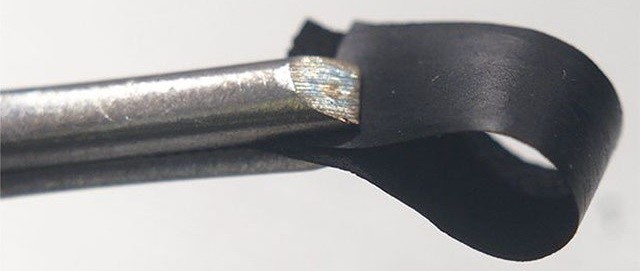HC Plastics News: Professor Huang Jiaxing of Northwestern University uses an inexpensive solvent called cresol, a common chemical commonly used in household cleaners. And it has developed a method for manufacturing dispersed carbon nanotubes, which does not require any additives or harsh chemical reactions, and can be realized only by using high concentration cresol modified nanotubes. As shown in the figure, the researchers found that using high concentrations of cresol can disperse carbon nanotubes into ordinary plastics. What is even more surprising is that Professor Huang also found that as the concentration of nanotubes increases, the material changes from a dilute dispersion to a thick paste, and then to a self-standing gel, which finally becomes moldable and Molded kneaded dough. "In view of its excellent mechanical properties, thermal and electrical properties, carbon nanotubes have attracted widespread attention in many applications, but after decades of research and development, some researchers are no longer so keen on these studies." Professor Huang Jiaxing from the Department of Materials Science and Engineering, Northwestern University's McCormick School of Engineering said. The processing of carbon nanotubes has been very difficult, especially in high volume processing. According to relevant data, the tubular structure of carbon nanotubes is about 10,000 times thinner than human hair, but it is stronger than steel, and its thermal and electrical conductivity is much better than copper. But when mass-produced (usually in the form of powder), the pipes twist and gather together. This complex situation is the main problem that hinders the widespread use of this material. “The aggregated pipes are difficult to disperse in the solvent. If the carbon nanotubes cannot be dispersed evenly, the high-quality nanotube film required for the application cannot be produced,†explains Professor Huang. To solve this problem, researchers have used additives to coat nanotubes to chemically modify them and force them to separate. Although effective, this method leaves residue or changes the surface structure of the nanotubes, thereby impairing its desirable properties. In contrast, Professor Huang’s team found that cresol does not destroy the surface function of carbon nanotubes. Also, after separating the entangled tube, the researcher can simply remove the chemical by washing or heating until the solvent evaporates. After unlocking a new way to make high-concentration carbon nanotubes, Professor Huang and his team discovered new forms of this material. As the concentration of carbon nanotubes increases, the material changes from a dilute dispersion to a spreadable paste, which in turn transforms into a self-standing gelatinous form, which eventually becomes a kneaded dough. These different forms can be molded, reshaped or used as conductive inks for 3D printing. “The dough state of nanotubes is very fascinating. Just like plasticine, it is easy to shape and can be shaped into arbitrary structures,†said Kevin Chiou, a graduate student at Professor Huang's lab and the first author of the paper. “In essence, this solvent system makes nanotubes behave like polymers, especially when phenol-based solvents are used to make once difficult to process carbon nanotubes as ordinary plastics. People are excited," said Professor Huang. Editor in charge: Yao Chunlin Cutting is an essential basic tool in the processing of ceramic components. Laser cutting technology has been favored for its non-contact, flexible, high efficiency and easy to achieve digital control. It is hoped that this high-energy beam processing method can be treated like metal materials. Complete the non-destructive cutting of ceramics. With laser as processing energy, the development potential in hard and brittle ceramic processing has been seen. It can realize contactless processing and reduce the damage caused by contact stress to ceramics. Ceramics have higher absorption rate for laser, focusing The energy of the high-energy laser beam acting on the local area of the ceramic can exceed 108 J/cm2, and the material can be melted and evaporated in an instant to achieve high-efficiency processing. Laser Cutting Ceramics,Alumina Ceramic Substrate Sheet,Tobacco Laser Cutting Nozzle,Machinable Ceramic Filter SHENZHEN HARD PRECISION CERAMIC CO.,LTD , https://www.hardcm.com
